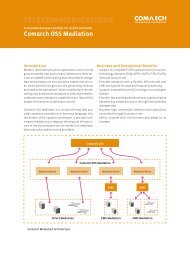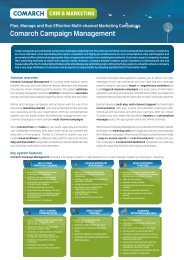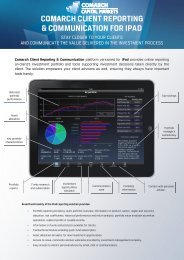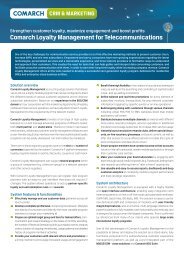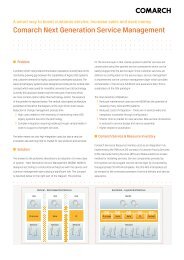Business Models in TelecoMMunicaTions - Comarch
Business Models in TelecoMMunicaTions - Comarch
Business Models in TelecoMMunicaTions - Comarch
Create successful ePaper yourself
Turn your PDF publications into a flip-book with our unique Google optimized e-Paper software.
6 > In Focus<br />
Figure 2 Mobile Advertis<strong>in</strong>g Revenue Growth, Worldwide, 2006-2011<br />
Source: Gartner (January 2008)<br />
14, 000<br />
12,000<br />
10, 000<br />
8,000<br />
6,000<br />
4,000<br />
2,000<br />
0<br />
2006 2007 2008 2009 2010 2011<br />
The emergence of these new merchants and<br />
providers <strong>in</strong> the mobile arena leads to additional<br />
revenue, but not necessarily for telecommunications<br />
service providers. Mobile service aggregators<br />
like Google, Yahoo, Apple or Facebook are already<br />
explor<strong>in</strong>g this market and are succeed<strong>in</strong>g <strong>in</strong> monetiz<strong>in</strong>g<br />
mobile advertiz<strong>in</strong>g. End-customers pay only<br />
a part of the price of mobile services while the rest<br />
of the revenue is collected from advertisers.<br />
Forecasts predict significant growth of the<br />
mobile advertis<strong>in</strong>g market over the next few years.<br />
This will be possible due to <strong>in</strong>creas<strong>in</strong>g adoption<br />
of mobile <strong>in</strong>ternet as well as implementation of<br />
larger screens on mobile devices, leav<strong>in</strong>g more<br />
real estate for advertisers.<br />
Transformation of advertis<strong>in</strong>g expenditure and<br />
new opportunities for advertisers also contribute<br />
to changes <strong>in</strong> the bus<strong>in</strong>ess model for mobile providers.<br />
First of all, a mobile device stays with the<br />
user all day. We grab our phones when we wake<br />
up and keep <strong>in</strong>teract<strong>in</strong>g with them until we go to<br />
sleep. There is no other market<strong>in</strong>g channel that provides<br />
similar, cont<strong>in</strong>uous contact with the target.<br />
Users listen to the radio, watch TV, use computers<br />
or read newspaper for only few hours a day. Mobile<br />
phones are with customers all the time.<br />
Some may say, hav<strong>in</strong>g constant access to the<br />
customer does not necessarily mean more ads can<br />
be delivered. But what if ads can be perfectly targeted<br />
and provided precisely when and where they<br />
are really needed? What if advertisers know who<br />
the customer is, where they are located and what<br />
they are look<strong>in</strong>g for? Correctly targeted advertis<strong>in</strong>g<br />
could be appreciated, if not desired, by customers<br />
and result <strong>in</strong> dramatically improved response rates.<br />
Technologies like mobile RFID, LBS, 2D bar codes<br />
and real-time video process<strong>in</strong>g support mobile<br />
market<strong>in</strong>g and enable accurate target<strong>in</strong>g, mak<strong>in</strong>g<br />
it significantly more attractive to customers than<br />
any other form of advertis<strong>in</strong>g.<br />
Over the past few years many consumers, especially<br />
the younger generations, have realized that<br />
social networks take communications to the next<br />
level. Instead of send<strong>in</strong>g vacation pictures to our<br />
friends and family or call<strong>in</strong>g them with <strong>in</strong>vitations<br />
to birthday parties, consumers now use social networks<br />
to let the outside world know about their<br />
lives. It seems only natural for users to move from<br />
the desktop application to the mobile term<strong>in</strong>al and<br />
take their social network on the go. For the mobile<br />
<strong>in</strong>dustry, this fact represents a significant change,<br />
even a revolution. For many users, the mobile version<br />
of Web 2.0 could become the most commonly<br />
used application on their phones.<br />
All this puts tremendous pressure on traditional<br />
voice and data service providers. Analysts predict<br />
that by 2012, the number of traditional mobile<br />
voice m<strong>in</strong>utes <strong>in</strong> Europe will drop by more than<br />
40%, and will be replaced by other applications<br />
like VoIP, social networks or click-to-call.<br />
Carriers are try<strong>in</strong>g to navigate this new world by<br />
offer<strong>in</strong>g next-generation applications that could<br />
respond to the new demands of customers and<br />
prevent them from mov<strong>in</strong>g to third-party providers.<br />
Is this the right direction for carriers? Shouldn’t<br />
they accept the fact that the best applications will<br />
be developed by those who specialize <strong>in</strong> these<br />
areas? Carriers have a lot to offer as aggregators,<br />
comb<strong>in</strong><strong>in</strong>g networks with third-party applications,<br />
content and advertis<strong>in</strong>g. Platforms equipped with<br />
the follow<strong>in</strong>g attributes provided by carriers would<br />
become unique and valuable propositions for <strong>in</strong>dependent<br />
application providers.<br />
> Their own customer base<br />
> Their own network<br />
> Brand recognition<br />
> Market<strong>in</strong>g data<br />
> Location data<br />
> Identity and Authentication<br />
> Policy Management<br />
> Established <strong>in</strong>voic<strong>in</strong>g and payment channel<br />
Customer-centric vs. telco-centric<br />
model<br />
Depend<strong>in</strong>g on how mobile carriers react to the<br />
chang<strong>in</strong>g market environment, there are two overarch<strong>in</strong>g<br />
models that can be foreseen as a future<br />
configuration of the mobile <strong>in</strong>dustry. Carriers will<br />
either cont<strong>in</strong>ue to position themselves as dom<strong>in</strong>ant<br />
service, content and device providers, or they<br />
will adjust to changes by offer<strong>in</strong>g attractive delivery<br />
platforms for external third party providers.<br />
In the first scenario, carriers would not be able to<br />
compete with other providers, and could merely<br />
become “bit pipes” los<strong>in</strong>g a significant part of the<br />
revenue. In this customer-centric model, carriers<br />
lose their dom<strong>in</strong>ant role <strong>in</strong> the value cha<strong>in</strong>. This is<br />
very analogous to what happened to <strong>in</strong>ternet service<br />
providers. ISPs have no control over where<br />
and what equipment customers buy as long as it<br />
is compatible with their networks, what service<br />
customers use for email, IM and VoIP calls, who<br />
the content provider is, and ultimately who delivers<br />
ads. The ISP is just a part of the value cha<strong>in</strong><br />
technology review [www.comarch.com]



